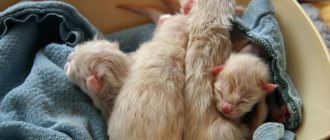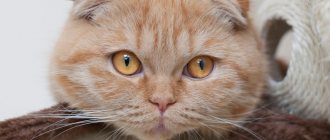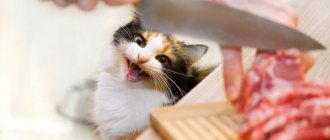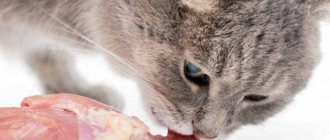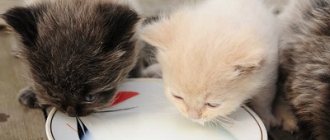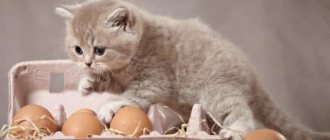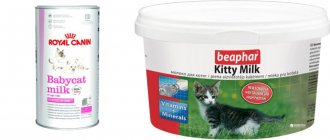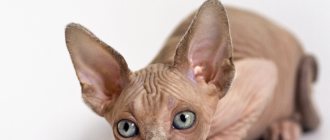Many owners of these cute animals face the problem of how to feed a kitten without a cat. The fact is that sometimes situations arise when a mother cat dies or, for some reason, refuses to feed her kittens. In this case, the mother for them should be the owner of the animal, who will have to feed it on his own. If he has information on how to feed a small kitten without a cat, he can easily cope with this task.
Many owners of these cute animals face the problem of how to feed a kitten without a cat.
How to feed a newborn kitten
The first question a person asks in such a situation is how can one feed a newborn and what can be given?
Of course, if it is possible to place a kitten on a cat that feeds kittens so that she can take it for food, that would be ideal.
You should make sure that the nursing mother is healthy and cannot infect the kitten with infectious diseases and parasites.
Most often, lactating cats accept other people's kittens and feed them along with their own offspring. But finding a wet nurse can be difficult, so you should look for another way out of the situation. A person is quite capable of coping with the process of caring for a newborn kitten, choosing special feeding products and creating a diet.
The process of feeding the baby will take several weeks and will be quite labor-intensive until the kitten learns to eat on its own.
Feeding is, of course, the most important process in caring for a newborn. But, besides this, the kitten also needs other care. The cat warms its kittens by constantly being nearby (especially in the first time after birth), licking and caressing them.
Therefore, a person must provide the kitten with cleanliness, warmth and affection. Children, even blind and helpless ones, are aware of how they are treated. Kittens calm down if they are fed and warm.
What else is needed to feed kittens?
After you have learned how to feed a kitten without a cat, it is also worth getting an idea about caring for it during the feeding period. So, for this you need to perform the following manipulations:
- make a heated nest for your charges;
- ensure hygiene in it;
- ensure the removal of waste directly from animals.
The temperature of the nest for a kitten should correspond to 38 °C.
As for the nest, its temperature should correspond to the average temperature of a cat - 38 °C. The thing is that the first 2 weeks of life require creating an increased temperature for kittens, which is generated by a cat under normal conditions. In order to achieve this effect artificially, it will be necessary to make a nest for them from baby diapers or fabric. To maintain the optimal temperature in it, you need to put an electric heating pad, a hot water bottle or a regular heating pad in it.
It is best to wrap the heating pads and bottle in a rag or towel. As for hygiene, it is worth periodically making a new nest and throwing away the old one. To prevent waste from spreading across the floor, it is necessary to place the nest in a basin; it is best not to use a paper box for this purpose.
Nursing kittens should be protected from drafts
Hygienic procedures must also be taken for the animals themselves. The fact is that in nature, kittens are cleaned by the mother cat. With artificial feeding, for obvious reasons, a person must take over its functions. This can be done using a special cloth glove. Until the animals grow up, it is better not to bathe them.
Important! Breastfeeding kittens must be protected from drafts, so when cleaning the nest they must be placed in a warm place, sheltered from the wind.
In addition, be sure to give your babies something to drink, unless, of course, there is a large amount of moisture in the nutritional mixture. Only by performing all procedures carefully and on time, you will be able to raise healthy and beautiful kittens, which over time will become your pets.
What can you feed newborn kittens?
What can you feed newborn kittens? Of course, milk immediately comes to mind. And this is where the main mistake lies.
Cow's milk should not be used to feed a newborn furry baby. The protein of such milk is practically not absorbed by the animal’s small body; cow’s milk can form lumps in the pet’s stomach.
It is undesirable to use goat's milk in the diet. Its fat content exceeds what is acceptable for a small organism. Because of this, the animal may experience severe digestive problems, and in some cases, the kitten may even die.
It is best to feed babies with a formula designed specifically for newborn kittens. Such products are sold through veterinary stores. The composition of this food closely matches the composition of cat's milk, so it will provide the kitten with all the substances necessary for growth and development.
If you suddenly couldn’t find a similar formula for kittens (and in small towns it’s really difficult to get it), buy baby food for newborns, it’s better than regular milk.
The body temperature of cats is 38 degrees, the mixture that you are going to feed the kitten should be heated to about 36.
The nutritional mixture should be prepared immediately before you are going to feed the kitten. Mixture dissolved a few hours ago should not be given to kittens.
How to reduce the risk of abandonment of offspring
Try to follow the basic rules:
- the cat should have a warm and quiet place for giving birth and subsequent feeding of kittens;
- the cat should eat food high in nutrients;
- there is no need to touch kittens in the first two weeks of their life unless necessary;
- other pets should not have access to the cat with kittens, including the cat.
If the cat does abandon the little kittens, there are other possible reasons:
- the cat is too young and this is her first birth;
- too many kittens;
- after giving birth, the cat developed complications, for example, mastitis;
- the cat has no milk;
Contact your veterinarian for advice. Try to feed the cat food with a high content of nutrients, move her house to a quiet and peaceful place - perhaps after a short time the maternal instinct will kick in and she will return to her cubs.
How to feed a newborn kitten?
Many “adoptive parents” have a question: how to feed a small kitten without a cat, since he doesn’t know how to lap? Feeding should be done from a special bottle designed for newborn kittens, which can be purchased at a pet store, from a pipette, a small medical bulb, or a syringe without a needle.
There is no difference in what to feed the kitten from. What is more important is what to feed and when.
Before feeding, dishes should be thoroughly washed and boiled. By using a sterile pacifier or bottle, you do not expose your kitten to possible infection with microorganisms and pathogenic bacteria. Remember! The immune system of such babies is not yet developed! Make it a rule to wash dishes immediately after feeding and sterilize them once a day. It is enough to boil everything you use to care for your kitten for 10 minutes.
Maintain personal hygiene when caring for your pet. Always wash your hands thoroughly before preparing formula and feeding your pet. Try to use fragrance-free soap at this time so that the baby does not inhale unnecessary aromas.
While feeding, the kitten should be picked up, placed on its tummy and its head raised. Place a pacifier or pipette in your mouth. If the cat eats this way for the first time, stroke his head and back, push the nipple slightly to feel it.
If you use a syringe for feeding, be careful not to damage the animal's nose and mouth, as the syringe has a hard surface and corners. If you are afraid to do this, take a pacifier or a pear; they will be easy for the kitten to grab and will definitely not hurt him.
To avoid injury and choking, do not push the tip of the pacifier deep into the mouth. The cat will grab it and determine the depth itself when it starts to suck. Be careful while feeding, make sure that the baby does not choke.
Please note that a newborn kitten should be fed in small portions both day and night at intervals of two hours. This diet should be followed for the first two weeks of life.
Next, a 3-4 week old kitten should be fed every 3 hours, and 4 week old kittens should be fed at intervals of once every 5-6 hours. Night feedings are mandatory for small kittens; if they are canceled, the animals will quickly weaken, lose weight and stop developing properly.
Therefore, owners who receive kittens without a cat should be patient and endure the first month of their life. A baby at this age cannot do anything on his own, and if he is abandoned and not cared for, he will not survive.
Feeding frequency and weight gain
Kittens 0–3 days old need food every 2 hours, regardless of the time of day. Babies' stomachs are tiny, and they need a lot of energy; in addition, the digestion process starts and stimulates the immune system. From 4 to 14 days, babies eat every 4 hours. Monitor the kittens' weight; poor weight gain is an alarming symptom that means developmental delays. Give those “lagging behind” more attention, hold the babies in your arms, feed them more often. Average norms for a kitten born weighing 90–100 g:
- 1 week – weight 115–120 g.
- Week 2 – weight 190–200 g – feeding 6–7 times a day, including at night.
- Week 3 – weight 270–280 g – we stop feeding the babies at night if they are sleeping.
- Week 4 – weight 360–370 g – feeding 5–6 times a day.
- From 4–5 weeks, complementary foods begin to be introduced, the number of feedings remains the same.
Consult with a veterinarian or veterinary pharmacy pharmacist - the baby needs vitamins that compensate for the meager “infant” diet. From available means you can use:
- Glucose – will help you actively gain weight – 1–2 g. for feeding.
- Tetravit, gamavit – vitamins and immunostimulant – 1 drop per feeding.
- Bone meal – useful for the formation of bones and joints – 1–2 g. for feeding.
- Fish oil is an immunostimulant and a source of vitamins, helps with constipation - 1-2 times a week, 1 drop per feeding.
- Vitamin A and D in ampoules - 1 drop per feeding.
What to feed a small kitten and how to calculate portions?
We described above what to feed a small kitten, but now we’ll tell you how to calculate the portion for one feeding. The serving size of the nutritional mixture depends on the weight of the cat.
The baby should receive the following doses of food for every 100 grams of weight:
- first week of life – 30 ml,
- second week of life – 35 ml,
- third week of life – 40 ml,
- fourth week of life and older – 50-55 ml.
See also: Cat clipper
This is the volume of mixture that a small kitten should receive during the day. Therefore, it is important to divide this small amount into several equal doses and give it to the baby without overfeeding him.
How to understand that the cat is full? If the newborn is full, he lets go of the pacifier or bottle and falls asleep. If he is still hungry, he will poke and squeak in search of a bottle.
If the kitten refuses to eat and becomes weaker, take it to the veterinarian; there may be some kind of disease. A healthy newborn pet will not refuse food.
After you have fed the kitten, place it tummy up and stroke it for a while without pressing. Sometimes your pet may begin to burp; this is quite normal, since the body is still small and reacts in this way to incoming food.
Then the baby should be placed in a bed or box, covered, a hot bottle placed under his side (mom simulator, ~40 degrees, more on that below) and allowed to sleep.
After four weeks, the kitten begins to eat on its own. You can gently poke his nose into the mixture so that it gets on his face. The cat will lick the mixture from its face and then begin to lap from the bowl.
From the time your baby begins to feed on his own, introduce other foods into his diet. It is recommended to start with meat infant formula, replace one meal with it, then alternate equally.
At the age of two months, the kitten can be switched from formula to kitten food. Pet stores offer a wide selection of food at different prices.
See also: What is a furminator?
Self-feeding kitten
At the age of three weeks, you can begin to introduce complementary foods into the kittens' diet. To avoid causing digestive disorders, portions should be very small, about the size of a pea.
What can and cannot be fed to kittens?
Can:
- food of soft and delicate consistency for kittens, preferably in the form of mousse.
It is forbidden:
- raw meat and fish;
- fatty, salty and fried foods;
- chocolate and sweets;
- food from your table.
How often should you give your kitten food? After introducing complementary foods, the frequency of feedings can be gradually reduced. In any case, consult your veterinarian regarding nutrition and introduction of complementary foods.
Hygiene procedures
In addition to nutrition, you should know other rules for caring for a newborn kitten. After eating, you can massage your cat's tummy clockwise with your fingers or the area under the tail, using a cotton pad soaked in water to empty the intestines.
Cats lick their cubs and try to keep their mouths, eyes, ears, and excretory organs clean. Wipe and wash the cat with warm and damp wipes, dry it so that it does not freeze after the procedures. Wash completely once a day in warm water.
The kitten needs a place to sleep and play at first. To begin with, a deep box is suitable, in which you need to lay soft bedding.
Cover your cat's area with old diapers or cut-up sheets so they can be easily washed or thrown away.
A cat abandons kittens: a mistake of youth
But too young an age may well be the reason why a cat abandons her kittens and leaves. There is a time for everything - this phrase is most suitable for young, in the literal sense of the word, mothers.
Alas, in mammals the maternal instinct sometimes manifests itself later than the sexual instinct. Owners of unsterilized young cats should keep this issue under control if they do not want to be left alone with blind, helpless squeaking lumps. True, it happens that motherhood still returns the cat to her babies on the second or third day after birth.
Hot water bottle for a newborn kitten
The cat warms its kittens, but in its absence, the baby should be provided with bottles of warm water, heating pads, and covered with terry cloth to keep them warm and soft. You can use a lamp that will warm the baby from above.
Ideally, the temperature of the place where the newborn kitten is kept should be equal to or slightly exceed 30 degrees. From the middle of the second week of life, the temperature of the kitten can be reduced, gradually bringing it to room temperature. During airing, the box with the kitten should be taken to another room.
Make sure that the box where the newborn kitten is located is always warm, dry and clean. Excess bacteria that appear when dirt appears can harm the baby's health.
Thus, we found out that a newborn kitten can be saved and fed even in the absence of a cat. It is important to provide your pet with food, cleanliness and care. Don’t forget to pick up the cat, talk to it, stroke it, and after a while you will definitely hear a grateful purr in response.
Amount of formula for one feeding
It’s not difficult to determine whether a kitten is getting enough. Hungry babies constantly squeak and crawl in search of their mother. If you present them with a finger, they immediately strive to suck it. Well-fed kittens are calm and... Having eaten, they go to bed.
There are also certain physiological factors that indicate both that the baby is overeating and that he is undernourished. We're talking about kitten poop :
- With slight overfeeding - liquid and yellow
- With moderate overfeeding - greenish
- With constant overfeeding - gray
Please note that you need to pay special attention to gray or white feces, as these colors of feces may indicate infectious diseases in the kitten.
If the kitten is malnourished, it sleeps little, trembles, squeaks and is lethargic. Besides that, kittens. Babies who receive too little food practically do not gain weight.
© shutterstock
What you need for feeding
To feed your pets you need to purchase everything you need.
What you need to feed a kitten:
- Special mixtures, nutrition.
- Cat milk substitutes.
- Pipette, disposable syringes without a needle or with a rubber nozzle;
- Bottles with nipple. Use the Catac kitten feeding bottle.
- Disposable moisture-absorbing diapers, cotton pads.
- Medicines for intestinal colic for infants.
Important! There are ready-made kits on sale for feeding small kittens, which contain all the necessary tools and utensils.
Read also: I have a fever. What to do?
Please note that whole cow's milk is not suitable for feeding a newborn kitten. The lactose contained in it is not absorbed by the gastrointestinal tract of kittens and can cause intestinal upset.
Until you purchase a cat's milk substitute or infant formula, it is better to use goat's milk for feeding.
If this option is not possible, boil low-fat cow's milk, dilute it with water by half, add one raw yolk, a little honey or sugar or 3-4 drops of glucose. For 500 ml of milk 1 egg yolk, 4 tsp. Sahara.
Take care of your kitten's hygiene
When a kitten has a mother, she licks him regularly. This way the kitten stays clean and learns to take care of itself. If there is no mother, this task falls on your shoulders.
You need to clean your kitten's fur after every feeding. It is enough to simply wipe the baby with a slightly damp soft cloth with short lint (this cloth resembles a mother’s rough tongue). If the kitten is very dirty, you can wash it in warm water. After washing, be sure to dry and warm the kitten.
Check your ears regularly. If they become dirty, they can be cleaned with a cotton pad or cotton swab.
At the age of eight weeks, the kitten can be given to a permanent home. At this age, babies already eat and drink on their own, go to the litter box, have been examined by a veterinarian and have had their first vaccinations. Kittens that have been raised by humans may require more attention and care from the owner. This should be taken into account when you are choosing a new home for your kitten.
Now you know how to feed a kitten and take care of its health. We wish you good luck and are sure that everything will work out for you!
No milk
For example, due to a hormonal imbalance caused by childbirth, the animal simply does not produce milk. The same thing happens to cats after anesthesia for caesarean section. Lack of lactation is one of the reasons why a cat leaves newborn kittens.
Also, in cats that have recently given birth (especially in very young and, conversely, older cats), endometritis often occurs - inflammation of the uterine mucosa. In this case, mothers simply lose milk, and they run away from their babies or throw them out of the “nest”: this is what nature dictates.
In addition, mother cats often experience mastitis, that is, inflammation of the mammary glands, and the feeding process becomes so painful that they have no choice but to escape from the kittens and from the painful sensations.
[custom_ads_shortcode3]
Caring for orphan kittens
When raising orphans, it is important to monitor the sanitary condition of the nest. To arrange it, it is better to use disposable baby diapers. Cleanliness for newborn babies is the key to health and prevention of viral infections.
Orphan kittens, especially at newborn age, have no chance of survival without human help. Only competent actions of the owner, application of knowledge about the physiology of newborn animals, patience, love and care for helpless furry creatures will help preserve the life and health of the cubs left without maternal care.
Feeding babies without a mother is not as easy as it might seem. It’s especially difficult to get through the first week together. However, the experience of many breeders proves that even if a cat refuses her babies, it is quite possible to get them out on their own. The main thing is to have enough strength, patience and, of course, knowledge of the basic rules.
Instructions for the care and feeding of newborn kittens. Animals are more likely than people to abandon their offspring; there are many reasons for this. In this article we will tell you why the cat abandoned her kittens and how to feed them.
[custom_ads_shortcode2]
Cat leaves kittens due to stress
Stress may well cause a cat to abandon its own children. For example, excessive attention to a cat during childbirth or constant visits from strangers to the nest where a mother and newborn kittens are located cause excessive anxiety in the animal and can provoke atypical behavior.
The cause of psychological trauma can also be an unsafe nest location from the cat’s point of view (that is, a box or basket that serves as a postpartum chamber) or the appearance of other pets in the house.

